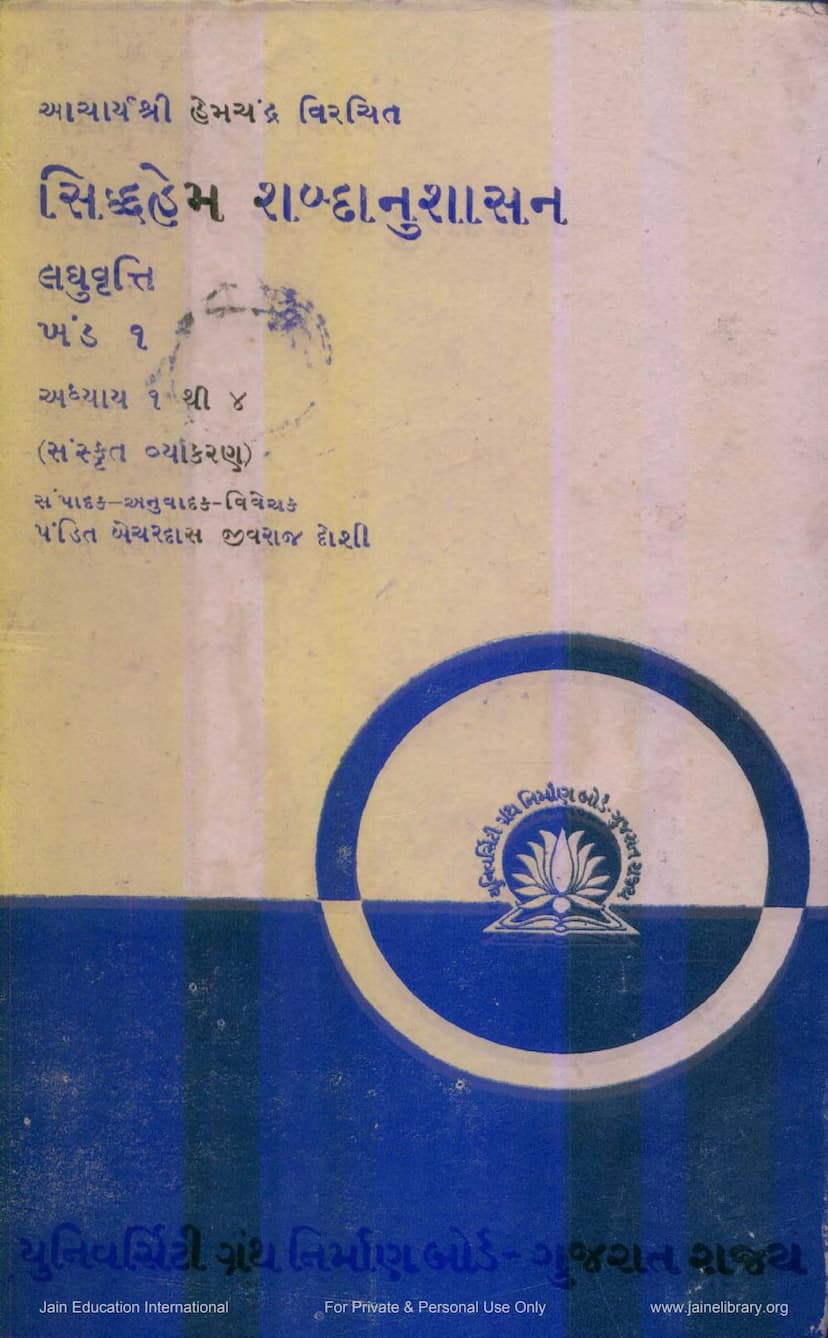Siddhahemshabdanushasana Part 1
Added to library: September 2, 2025

Summary
This is a comprehensive summary of the provided Jain text, "Siddhahemshabdanushasana Part 1" by Bechardas Doshi, as found on page 1 through page 6 of the provided document. This summary focuses on the introductory sections and outlines the scope of the work.
Book Title: Siddhahemshabdanushasana Part 1 Author(s): Bechardas Doshi (Editor-Translator-Commentator of Laghuvritti) Original Author of Siddhahemshabdanushasana: Acharya Hemacandra Publisher: University Granth Nirman Board, Gujarat Rajya
Overall Scope of the Volume:
This first volume of the Siddhahemshabdanushasana, specifically the Laghuvritti (minor commentary), covers Sanskrit grammar. It is divided into Books 1 through 4 of the original text.
Publisher's Foreword (Page 4):
The University Granth Nirman Board, Gujarat Rajya, was established in 1970 with the aim of preparing extensive literature for university-level studies in regional languages, with financial assistance from the central government. Since April 1, 1976, the state government also provides financial support for this initiative. The board publishes textbooks and reference works covering university-level syllabi, often with critical commentary and translations, prepared by university professors and scholars. This particular publication, the Siddhahemshabdanushasana by Acharya Hemacandra, is part of this series, and its editing, translation, and commentary have been undertaken by the knowledgeable and experienced scholar, Pandit Bechardas Jivaraj Doshi.
Structure of the Publication:
Due to the extensive nature of the text, the Siddhahemshabdanushasana has been divided into three volumes for the convenience of readers:
- Volume 1: Books 1-4 (Sanskrit Grammar)
- Volume 2: Books 5-7 and the Dhatupatha (list of roots)
- Volume 3: Book 8 (Prakrit Grammar)
This volume (Volume 1) presents Books 1-4 of the Sanskrit grammar.
Preface/Introduction (Page 6):
The primary objective of the University Granth Nirman Board is to assist students pursuing higher education. The board strives to provide high-quality books suitable for advanced studies, as such specialized literature is not always published by other institutions.
This particular publication, covering the first four chapters of the eight-chapter Siddhahemshabdanushasana, is intended for students and scholars of Sanskrit. The Board also publishes literature for students of Prakrit languages, such as the 'Deshishabdasangraha' (collection of indigenous Prakrit words).
Content Overview of the Siddhahemshabdanushasana:
The original text comprises eight chapters:
- Chapters 1-7: Deal with Sanskrit grammar.
- Chapter 8: Specifically covers the grammar of Prakrit languages, including Sauraseni, Magadhi, Paisachi, Chulika Paisachi, and Apabhramsa.
Detailed Introduction to Chapters 1-4 (Sanskrit Grammar) (Pages 7-45):
The provided text offers a detailed breakdown of the content within the first four chapters of the Siddhahemshabdanushasana:
-
Chapter 1:
- Pada 1 (Section 1): Focuses on Sanjna (terminology). It begins with the auspicious invocation (Mangalacharan) of "Om" (represented by 'M'). The author explains the significance of "Om" in Jain and Buddhist traditions, encompassing various deities and concepts of liberation. It covers 22 sutras defining terms like svara (vowel), hrasva (short), dirgha (long), pluta (prolated), samana (equal), anusvara (nasal sound), visarga (aspirate), vyanjana (consonant), ghosa (voiced), aghosha (unvoiced), antahstha (semi-vowels), sandhyakshara (diphthongs), and pratyaya (suffix).
- Pada 2: Deals with Sandhi (euphonic combination), covering both Svara Sandhi (vowel combination) with 41 sutras and Vyanjana Sandhi (consonant combination) with 65 sutras, totaling 106 sutras for Sandhi.
- Pada 4: This section, along with the first pada of the second chapter, covers the process of forming Sanskrit nominal stems (namani) by applying case endings (vibhakti). It explains how nouns ending in vowels (svaranta) and consonants (vyanjana) are treated, along with common and specific noun forms. This section spans 93 sutras in Pada 4 of Chapter 1 and 118 sutras in Pada 1 of Chapter 2, totaling 211 sutras on nominal forms.
-
Chapter 2:
- Pada 1 (Continued): As mentioned above, this pada continues the discussion on nominal forms, concluding the treatment of case endings and the derivation of various noun forms.
- Pada 2: Focuses on Karaka (case relations) and the application of different vibhaktis (case endings) to indicate these relations. It details the six karakas: Kartr (subject), Karma (object), Karana (instrument), Sampradana (dative), Apadana (ablative), and Adhikarana (locative), along with other relational uses of cases. It includes rules for indicating genitive case relationships and mentions secondary nominals like janya-janaka (cause-effect) and prerya-preraka (cause-inducing agent). This section contains 124 sutras.
-
Chapter 3:
- Pada 1: Begins with Upasarga (prefixes) and their classification (23 sutras). It then moves to Samasa (compounds), extensively detailing various types: Bahuvrihi (possessive compounds, 18-25 sutras), Avyayibhavatattpurusha (adverbial compounds, 26-41 sutras), Tatpurusha (adjective-noun compounds, 42-95 sutras), Karmadharaya (adjective-noun compounds, 96-116 sutras), and Dvanda (coordinate compounds, 117-147 sutras). It also covers Ekashesh (exclusive compound) and the rules for Purvanipada (order of words in a compound). This pada has a total of 163 sutras.
- Pada 2: Focuses on the transformations (vikara) that occur in nominal forms when they undergo compounding. It covers various rules related to how sounds change within compounds, including specific rules for words like Gomata. This section contains 114 sutras.
- Pada 3: Begins the discussion on Kridanta (verbal derivatives or participles) and Taddhita (nominal derivatives) by explaining the formation of verbal forms from dhatus (roots). It mentions that Hemacandra's Dhatupatha lists 1981 roots categorized into ten ganas (classes). It also provides brief examples of verb conjugations (e.g., kachati, vartati, malati) in the present tense, indicating how different vikaranas (augmenting vowels) are used for each gana. It also touches upon causative (preraka), desiderative (iksha), and other verbal forms. This pada contains 66 sutras.
- Pada 4: Completes the discussion on nominal forms (namani), covering the application of various vibhaktis (case endings) and their specific meanings. It also elaborates on the formation of feminine (strilinga) forms using suffixes. This pada contains 98 sutras.
Overall Objective:
The text is presented as a valuable resource for students and scholars of Sanskrit grammar, aiming to make the complex rules of grammar accessible through detailed editing, translation, and commentary by Pandit Bechardas Doshi. The publisher, University Granth Nirman Board, emphasizes its commitment to providing high-quality academic literature in regional languages.